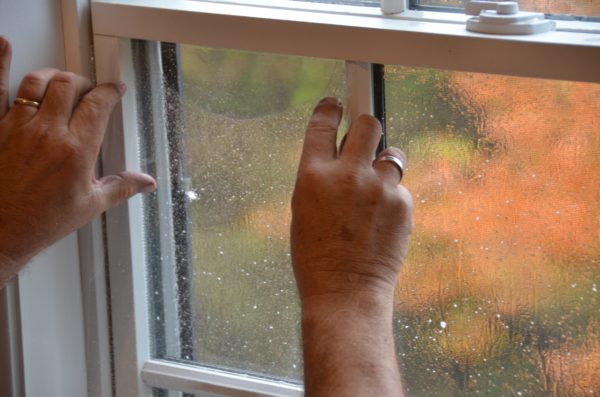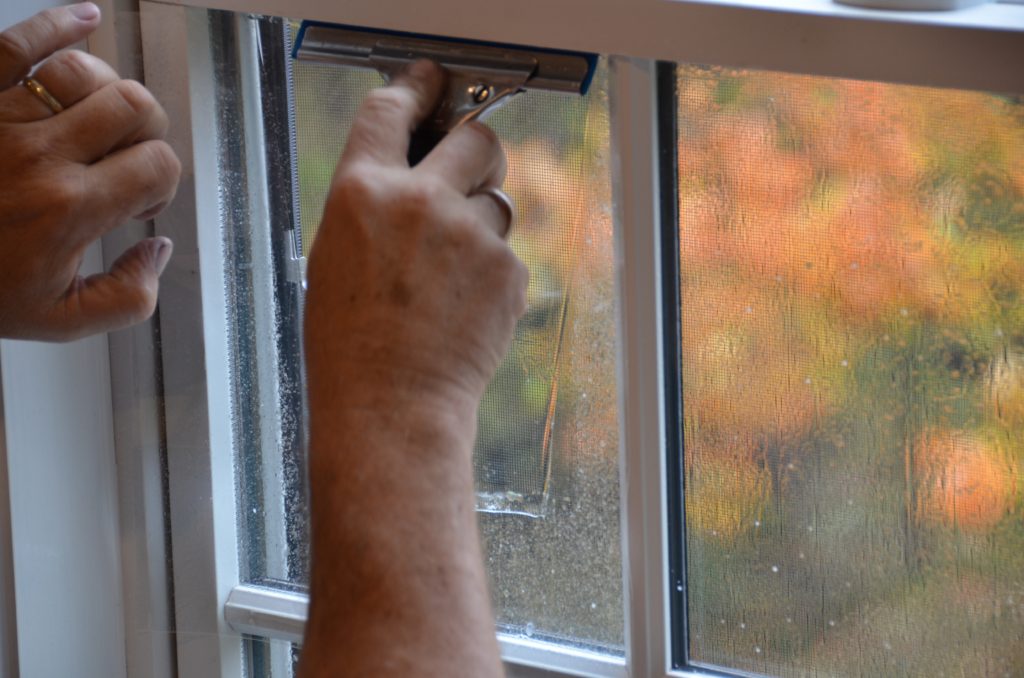
Tempered Window Alternative – Code Compliance Safety Film
I recently remodeled a home and hired a reputable window company to measure and supply all the windows. One item that the window rep and I both missed was that both bathroom windows should have been specified with tempered glass. We missed it and rightfully so, got called out by the building inspector. Replacement sashes would have cost at least $600-800 per window. There had to be a solution, it turned out there was; window safety film.
Building Code
In Massachusetts, the building code, 780 CMR 2401 [Chapter 24] covers glass and glazing requirements. For bathroom windows, safety glass is required in enclosures for or walls facing hot tubs, whirlpools, saunas, steam rooms, bathtubs and showers where the bottom exposed edge of the glazing is less than 60 inches (1524 mm) measured vertically. Glazing in any portion of a building wall enclosing these compartments where the bottom exposed edge of the glazing is less than 60 inches (1524 mm) above a standing surface.
There are 2 types of bathroom window safety glass than can be used as long as they meet 16 CFR 1201 Class II impact standard (400ft lb)
- Laminated glass – sandwiched sheet of plastic foil between the glass panes. If broken, plastic holds pieces of glass together and prevents injury.
- Tempered glass – glass is heat treated during manufacturing. If broken, crumbles into small pieces, similar to a car window.
Other items in a bathroom also require tempered glass, such as: shower enclosures, and glass at hot tubs, showers, spas, whirlpools, saunas, and steam rooms. [Note – reference building code for full and accurate details]
Safety Glass Standards
Safety glass standards ANSI Z97.1 and CPSC 16 CFR 1201 are all about reducing the risk of death and laceration in the event you fall through and break the glass. Accidents happen, many times, slip and falls result in people falling into glass.
Safety glazing standards have done a very really good job at reducing the severity of broken glass laceration injuries and deaths. But what happens if you have an older house or if you made a mistake like we did?
4-Mil Window Safety Film – A Safety Glass Alternative Solution
Many older homes in the prior to these code requirements have large windows of ordinary glass that are not safety glass. Instead of replacing these windows, it is possible to strengthen the glass with window safety film products such as Scotchshield™ window safety film from 3M. Applied properly, the material is durable, effective and does not change the look of the glass. Window safety film is a thin layer of clear flexible film plastic applied to the back of the glass, this 4-mil safety film holds the glass pieces together if broken, reducing the risk of injury.
An installer can apply a label self-certifying that the glass complies with the CPSC standard. According to ICC Evaluation Service legacy report 94-41, the product qualifies as safety glass when properly installed. Many jurisdictions accept this, and the label is not likely to be present with a homeowner-applied film.
Storm Protection
An additional benefit to 4-mil window safety film offers protection during earthquakes, and wind related storms with flying debris. Flying debris can shatter window glass, sending shards of flying glass into a room. Window safety film holds the broken glass in place.
Home Security
While window safety glass will not stop an intruder, it will slow them down. slowing an intruder down while you home means buying you more time to call 911, escape, get to a safe room or defend yourself. Many security films are tear resistant and makes the window harder to penetrate and help hold glass fragments together after impact.
Solar Window Film
There are tinted, UV rated fiilms that reduce the amount of heat gained through transmission of sunlight. these window films can help you lower energy costs, eliminate hot spots, reduce glare and protect carpet and furniture from fading. Many of these films reduce up to 78% of the sun’s heat, evenly disperse natural light, reduce eye strain glare, and block up to 99% of harmful ultraviolet rays.
Window Safety Film Installation
Materials Needed
- 1/4 tsp of a no-tears baby shampoo without conditioner
- Spray bottle (mix baby shampoo and water)
- Bottled water (not tap water)
- 6″ Squeegee
- Break-away utility knife (for cutting film)
- Straight edge for cutting film
- Multiple single-edged razor blades (for cleaning glass)
- Tape measure
- Soft, lint-free cloth or paper coffee filters (for cleaning the glass and film)
Note – The soapy water acts as a lubricant for the squeegee during glass cleaning, film application, and future cleaning. Do not use any household glass cleaner containing ammonia or vinegar to clean the glass or film; it can dissolve the film adhesive.
Window Safety Installation Steps
Measure the Window
Measure the window carefully before unrolling and cutting the film. Film may be applied from side to side, or top to bottom. Use the measurement that leaves the least waste. Many installers pretrim the film to 1/16″ less, all sides, than the window dimensions.
Clean the Window
- Clean window with the soap solution.
- Squeegee to clean the windows thoroughly.
- Re-pray the glass, then use a razor blade to remove any dried paint or hardened dirt.
- Re-wet window, then squeegee downward.
- Wipe with a soft cloth or paper coffee filters.
- Repeat until the glass is clean.
Cut the Film
- Work on a clean, flat surface.
- Use a straight edge to cut the film.
- Use the factory edge of the film for one side of the window.
- If pre-trimming film to the final dimensions of each window, cut the 1/16” gap.
Wet the Window Thoroughly
- Wet glass with soapy water, it acts as a lubricant for the film.
- Keep the glass wet prior to applying film.
Remove the Film Backing
- Take care not to crease the film while removing the clear, backing of the film.
- Spray the soapy water onto the exposed adhesive as you peel back off
- Wet your hands with the Solution before handling the film to avoid leaving fingerprints on the adhesive.
- Tip: Remove the film back by attaching two 4” long pieces of transparent tape to the front and back surfaces of a corner of the film so that about 1” of tape is on the film, the rest centered and hanging over the pointed corner of the film. Press the two pieces of tape firmly together, then quickly pull them apart to begin separating the clear liner away from the adhesive side of the film.
Place the Film on the Wet Window
- Be sure the window is really wet.
- Apply the adhesive side of the film to the wet glass.
- Start at the top of the window, then allow the film to gently lay down onto the glass.
- Handle the film at the corners to avoid wrinkles or creases.
- Use your hands to smooth the film onto the glass.
- Slide the film around and position it.
Spray the Outside Surface of the Film and Squeegee
- Spray the entire surface of the film facing you with the soapy water to lubricate its surface.
- Using a clean rubber squeegee, begin squeegeeing the water and air out from under the film.
- Start about 2” from the top and side and squeegee from left to right.
- Lightly squeegee the rest of the film downward, but leave the 2” perimeter area unsqueegeed.
- If you need to remove large air pockets, rewet the top of the film and squeegee again. You can remove any large bubbles by pushing them with the squeegee to the nearest film edge. Small bubbles (less than 1/8” in diameter) should disappear in a few days.)
- If the squeegee drags, respray the film.
Trim Edges of Film and Squeegee Dry
- Use a sharp razor blade or utility knife and a 1/16” wide guide to trim the film around the four perimeter edges.
- This gap is for the proper thermal expansion of the glass and also allows the water to squeegee out
- Rewet the entire film surface and squeegee again.
- Press firmly to remove all the water to cure the adhesive.
- Start at the top of the window, squeegee from the center to the left, then from the center to the right.
- Repeat this process until you reach the bottom of the window.

